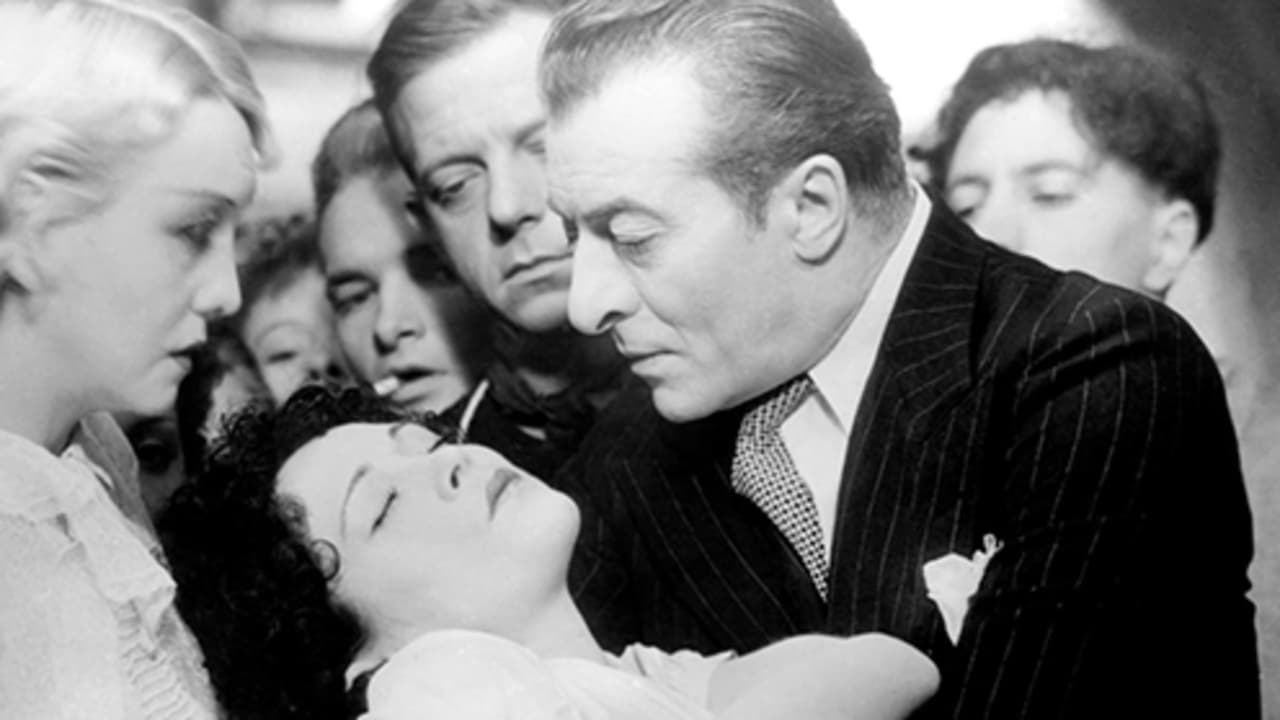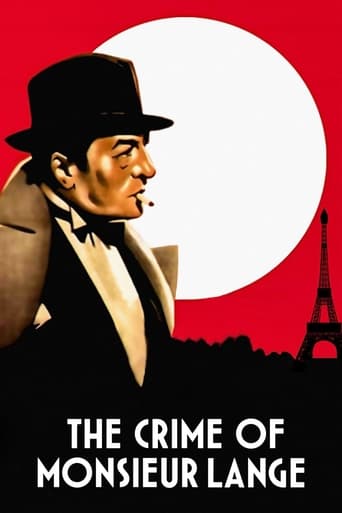

SERIOUSLY. This is what the crap Hollywood still puts out?
... View Morenot horrible nor great
... View MoreI was totally surprised at how great this film.You could feel your paranoia rise as the film went on and as you gradually learned the details of the real situation.
... View MoreOne of the worst ways to make a cult movie is to set out to make a cult movie.
... View MoreOften marked as "one of Renoir's greatest films," LE CRIME DE MONSIEUR LANGE is a platform for us to witness how a director can convert propaganda into memorable art. The script is full of wit but Renoir is the hero, here. He allows for multiple perspectives and concise characterization to produce a quick, jaunty, and bright film.LANGE is dense with insightful staging. Renoir had learned by 1936 that everything serves character. In some ways, he recalls the swift attitude in Hawks's comedies. The camera work is clearly more radical, but they both succeed with abundant charm and aim every device at the service of character. Visually, some usual complexities are reserved for the end where the street allows for at least two excellent tracking shots. LANGE presents some of the most precise and concise characterizations in the Renoir repertoire. Batala is given superior attention. If we compare him to the capitalist villain in something like STRIKE, we find that Renoir believes in the complexity of thought even when working with a simple and economic script. In his frequent manipulation of women, Renoir illuminates the tight bond between money, power, and sex. His metamorphosis into a priest is loaded with dubious criticism, but is still the source of comedy.The best component of LANGE might be the frequent allusions to Americana and westerns. It asserts that the American frontier was imbued with absolute freedom and the characters use it to focus their socialist fantasies. This parallel between socialist idealism and dreams of the West play incredibly well as an object of cinema. LANGE even gets its own joke -- "It's only a movie." The film is dense with the inimitable charm of Renoir, consistently exquisite photography, and forceful characterization. The comedy is presented with ease and subtlety. It is only unfortunate that so much of the commentary is excessively heavy. Capitalism comes back from the dead only to be defeated by Socialism. Socialism gets away with murder and walk happily out into infinity.79.7
... View More''LE CRIME DE MONSIEUR LANGE'' is a film that Renoir made as part of the Popular Front sympathies of the mid-30s when a co-alition of various organizations banded together in a show of collective solidarity under Leon Blum's leadership. It was this film which cemented Renoir forever after in the ranks of left-wing film-makers much to Renoir's bemusement years later and the film has been variously seen as a call-to-arms towards collective organization, as a film about the class conflict and oppression of workers and about creating a new social utopia. Such reductions do the film little justice because what seems an agitprop actually becomes murky.LE CRIME DE MONSIEUR LANGE begins with a flashback(a device Renoir rarely used) at a Frontier Hotel(which frontier is unspecified) where a guard brings in a wanted poster informing the bar patrons about Amedee Lange(Rene Lefevre), a fugitive on the run from the law. Lange and his sweetheart Valentine(Florelle) arrive at the hotel and are recognized by the patrons. Valentine decides to explain why Lange committed the crime of the title as he sleeps from exhaustion in his room. The film then begins and is set in a courtyard(brought to vivid life by beautiful set design and superb circular panning shots) where writers of a publishing firm reside. This publishing firm is run by Batala(Jules Berry in a great performance), a corrupt fabulist of an employer who loves sleeping with his female employees and crushing the spirit of his males.Berry's Batala is a caricature par excellence of a bourgeois businessman who will promote Lange's "Arizona Jim" stories in his magazine to make up for swindling his sponsors only to sabotage Lange's vision by inserting absurd advertisements into the mouth of his idealized and poorly researched Western hero. The film moves without a plot, smoothly scripted by the legendary poet-scriptwright Jacques Prevert(who worked with Marcel Carne and Jean Gremillon but this was his only work with France's best film-maker) driven by the actions and interactions between the workers of the publishing firm and their relationships with the girls who run the neighbourhood laundry. It's a portrait of class relationships like few others in film history making room for such expert caricatures as a old war veteran of an Indo-China conflict whose racism and colonialism is presented starkly.The film's key movement happens midway when the publisher Batala seemingly perishes in a train crash, leaving the publishing firm in disarray...the sponsors want their money back, the workers want to keep their jobs. By mutual agreement and mutual interests they form a co-operative and in this phase, class distinctions fall apart, middle-class businessmen eat side by side with writers and businessmen, corrupt reactionaries alongside progressives, women with men. The publishing firm which had been in tatters because of Batala's pretentious detective magazine Javert rejuvenates itself by making pulp fiction of "Arizona Jim" novels, fumetti and even discuss making a film(although Lange disagrees noting the impossibility of faking the American West in France...).The film's vision of co-operative society isn't one of classlessness but class co-ordination. The firm's major support comes from a dandy son of a bourgeois businessman, it passes into their hands through the aegis of an unconvincing distant relative of Batala who inherits the place when he "dies". Much of the film's strength comes from Renoir's effortless blocking of actors in group, with direct sound creating a palpable sense of place.The film's finale climaxes in a stunning coup, where the line between Lange and Arizona Jim blurs. Batala returns from the dead to take over his firm and rub out the work done without him and in an act of inspiration, Lange commits himself to assassinate Batala. This act is carried in two successive spellbinding tracking shots. The first is a crane shot of a high angle which follows Lange walking through three rooms down a stairs, the other is a breathtaking semi-circular pan in which Arizona Jim Lange defeats the bad guy and rescues his girl and then of course heads to the frontier.
... View MoreIt is a mistake to view this as a crime movie. The crime aspect is just a symbolic summary of the theme that Renoir developed in this movie.Essentially, this movie was about unbridled capitalism, personified by Batala, vs. the commutarianism of the publishing house after he "died".The "new era" at the publishing house was one of unbridled happiness and prosperity. Under Batala, the workers were starving while the boss was stealing and screwing people.My only disagreement with Renoir was that he spent too little time on the good times after Batala was gone, and too much on how Batala was a criminal. But perhaps he needed this to demonize him as well as he did.We know where Renoir's sympathies were since the protagonists get away in the end. A symbolic death of unbridled capitalism.
... View MoreThis film was a tiny bit predictable, otherwise it would have earned a 10. The story is about a decent but meek French man who writes cowboy stories (though he has never even been to the American West). He has no dream of having them published but feels a strong need to put his fantasies on paper. This is sort of a vicarious thrill for him because apart from his stories, his own life is rather dull and he is a failure with the ladies. Eventually, his sleazy boss who owns a magazine discovers his stories and agrees to publish them. Of course, being sleazy, there is a catch and the nice main character is, for a while, being used by this creep. However, where the story goes from there and how it goes there is intriguing and make this a must-see film.
... View More